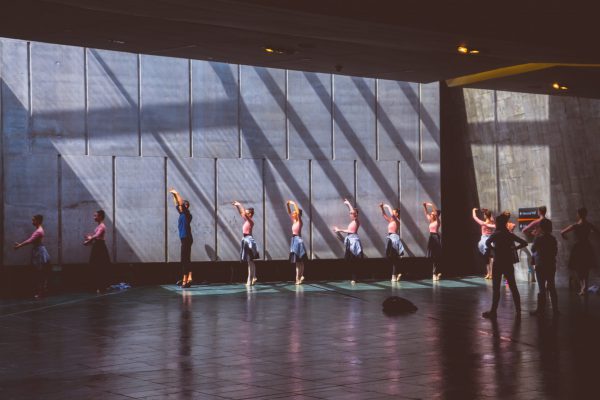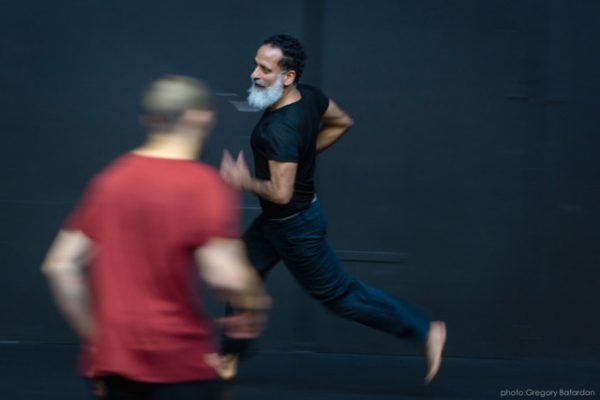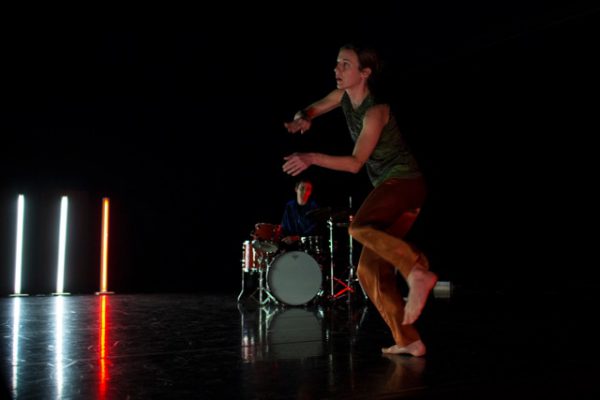As a critic, I tend not to reflect on my work: I guess I’m too busy pondering the dance I write about. But after two decades engaged in the usual bread-and-butter assignments for newspapers and magazines, more substantial reviews at thedancecurrent.com, several essays in anthologies and journals, as well as a few books, I feel the need to step back and take a close look at this pursuit to which I give so much time and effort. Not to make a cool assessment, but to forge a renewed path.
Early on in my career as a dance critic, I often wished for a psychiatrist sitting next to me on one side and an anthropologist on the other in order to ensure a clear, fair grasp of the art, free of my own prejudices and predilections. Twenty years later, I’m still juggling personal and cultural relativity, and a third ball has been added to the toss: the shifting ground of any experience of a choreographic work. However closely I watch, I can grasp only a part of the tapestry of muscle and tendon, heart and lungs, unfolding before me, and if I return the next night to check my impressions, as many questions will be raised as answered: with dance, you never get the same thing twice. Nor will my attention be the same: chances are I’ll notice a different pair of arms and legs, or blink and miss the moment I wanted to get closer to.
There is a reason, then, why dance is often described by the cliché “ephemeral”. As the American critic Arlene Croce said in the preface to her 1977 collection of reviews, Afterimages, dance criticism is “a fool’s job”, based on the impressions left behind when a performance is over, not on recorded fact.
It’s as if dance were created from some ghostly or metaphysical substance – yet the reality is quite the opposite. This romantically elusive art form is composed of the very tangible elements of flesh and blood, created through hard physical labour. Every time we watch a choreographic work, we are confronted at a deep, unconscious level by this paradox of the ephemeral and the concrete, which seems to speak to the very nature of life itself.
The existential significance of dance aside, how can I fulfill my job with expertise while focussed on juggling those three balls of personal, cultural and aesthetic relativity? Or should I forget the circus act, and soberly profess an absolute and unassailable grasp of the Canadian dance scene I cover?
Generally today, we believe in many small truths, not one big Truth. Physics has accommodated relativity, and as philosopher William James wrote in The Varieties of Religious Experience (1902): “The wisest of critics is an altering being, subject to the better insight of the morrow, and right at any moment, only ‘up to date’ and ‘on the whole.'”
My critical viewpoint is limited to a single perspective of, typically, one particular experience of a performance. This makes me uneasy about publishing definitive, thumbs up or down, judgements, or at least of overplaying them, and staying with description is tempting. I’m not the only contemporary critic drawn to a descriptive approach: art historian James Elkins in What Happened to Art Criticism? (2003) is aghast at the sea change from judgement to description in the field of visual art, calling it “an amazing reversal, as astonishing as if physicists had declared they would no longer try to understand the universe, but just appreciate it.”
In dance, which can’t be quoted directly, there is no way to put a choreographic work on the page except by describing it. The chances of a reader having seen the performance or viewing a remount in future are slim: most dance works have a short life, and tours are typically a few nights in a handful of larger cities. The descriptive critical record has greater importance than in other arts because it is often a reader’s only experience of a work.
Susan Sontag, in the title piece in Against Interpretation and Other Essays, made an impassioned plea for “really accurate, sharp, loving description of the appearance of a work of art,” calling for writing that reveals “the sensuous surface of art without mucking about in it.” This was her way of displacing heavy-handed interpretation where X really equals Y and art is reduced to a puzzle best solved by the (intelligent, sensitive, knowledgeable) critic.
This kind of overbearing critical voice was brilliantly parodied in Vladimir Nabokov’s novel, Pale Fire, published two years before Sontag’s 1964 manifesto. Here, the dead and hence helpless author, the fictional John Shade, becomes practically invisible next to Charles Kinbote, his determined, long-winded and quite possibly mad interpreter.
So, yes, conscientious description evoking the work of art is preferable to self-aggrandizing appropriation. Yet a critic is neither a publicist nor the artist’s champion and, like any audience member, must enter into and discover the work on independent terms. Donald Kuspit in “Art Criticism: Where’s the Depth?” (in The Critic is Artist: The Intentionality of Art (1984)), writes that art can only be significant if it is shown to connect beyond its appearance, and beyond what the artist might say about it, to the deeper world view and consciousness that it represents. The work of art should not be regarded “as simply another phenomenon and product in a world already crowded with them”, and it is the critic’s job to pursue the depth beneath the surface.
For both Kuspit and Elkins, describing art as if it is merely another chair or tree or car is not enough on its own to qualify as criticism, and Sontag’s own writing actually goes deeper. The essays on film and literature published in Against Interpretation do not just place readers in front of the artwork, though Sontag’s descriptive powers are acute: there is also context and comparison, all of which is woven together against a generous background of cultural and other ideas.
Nor does Sontag deny the instinctive act of judgement, the natural going toward or drawing away from an artwork, and this gives her writing focus and energy. The critic is not immune to art’s ability to touch or provoke, and a personal relationship with the work is a form of fuel that feeds “creative encounter”.
The term comes from psychologist Rollo May’s The Courage to Create (1975). “Artists,” he wrote, “encounter the landscape they propose to paint – they look at it, observe it from this angle and that.” What makes the encounter creative is “the degree of absorption, the degree of intensity … there must be a specific quality of engagement.” May believes creative encounter can also be found in the work of some scientists and in a mother’s relationship with her child. I see it as an ideal for critics, too.
May’s definition entails close observation of the object: for myself, the dance. Obviously, the intention is not to wallow in subjectivity by ignoring the steps and structure, costumes, lighting and music: the starting point for critical encounter is a genuine attempt to see the work exactly as it is, to pay attention to everything happening on stage. This is the bedrock on which the critic’s professionalism rests.
Because the sensuous surface of a dance passes by so quickly, the parameters for creative encounter are different than in other arts: it is not possible to investigate or savour at leisure. The dance critic, scribbling notes in the dark that are typically a tangle of barely legible words and phrases, must be alert and present to each moment as it races by on stage, to “be here now”, while constantly giving up that present moment – however seductive – in order to be there for the next.
“Do you ever just relax and enjoy yourself when you watch dance?” people sometimes ask. I usually do: when I’m in good shape, and the dance and dancers are, too, this peculiar form of meditation is an invigorating challenge. I take my job seriously, but this doesn’t mean it’s onerous. In fact, the focus and commitment of critical consciousness is most productive when the open-ended, free-spirited absorption of a child at play is present. The word “play” has become my catchword, and philosopher Immanuel Kant’s call for the “free play” of imagination and understanding in regard to aesthetic judgements sounds exactly right.
Where better to play than in the theatre? Psychoanalyst D.W. Winnicott considered play and cultural experience as vital interfaces between fantasy and reality. Both, he wrote in Playing and Reality (1971), take place in a “potential space” situated between inner subjective experience and the outer world. In Winnicott’s enticingly named potential space, a work of art is more than an intellectually perceived object: it’s an event in which we are deeply engaged. Here is where creative encounter takes place; here is where we dive into the art and into ourselves, watching and responding in depth so we can, in turn, write with depth.
The submersion into self is what makes the experience worthwhile. “[T]he play of art is not some substitute dream-world in which we can forget ourselves,” wrote philosopher Hans-Georg Gadamer (“The Play of Art” (1973)), but “a mirror … in which we catch sight of ourselves in a way that is often unexpected or unfamiliar: what we are, what we might be, and what we are about.”
In front of that fast-flowing stream of energetic movement, my ideal is to be fully feeling and immersed without sacrificing a more considered, objective point of view. Later, at the computer, I aim for a critically aware yet responsive approach, bolstering it with description – crucial to bringing dance alive on the page – and not shying away from judgement – that instinctive moving toward or away that fuels honest, engaged writing.
This call for a broadly based critical response that is also intensely personal grows out of my conviction that dance matters – that at its best it is Gadamer’s mirror reflecting both reality and possibility, worthy of a lifetime’s close attention, sustaining many dives deep into its depths.




